Hyundai Creta: Charging System / Battery
Description and operation
| 1. |
The MF(Maintenance Free) battery is, as the name implies, totally maintenance
free and has no removable battery cell caps.
|
| 2. |
The MF(Maintenance Free) battery does not require water replenishment
for the repair.
|
| 3. |
The battery is completely sealed, except for small vent holes in the
cover.
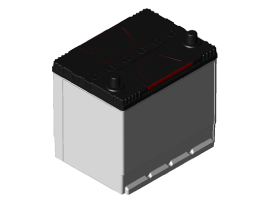
|
| • |
After disconnecting then reconnecting the battery negative cable,
reset some parts that require the reset procedures.
(Refer to Body Electrical System - "General Information")
|
|
Specifications
▷MF45L-BCI : OPENABLE
Item
|
Specification
|
Model type
|
MF45L-BCI
|
Cold Cranking Amperes (A)
|
410 (SAE)
|
Reserve Capacity (Min)
|
80
|
▷MF60L-BCI : OPENABLE
Item
|
Specification
|
Model type
|
MF60L-BCI
|
Cold Cranking Amperes (A)
|
550 (SAE)
|
Reserve Capacity (Min)
|
92
|
▷MF68L-BCI : OPENABLE
Item
|
Specification
|
Model type
|
MF68L-BCI
|
Cold Cranking Amperes (A)
|
600 (SAE)
|
Reserve Capacity (Min)
|
110
|
Components and components location
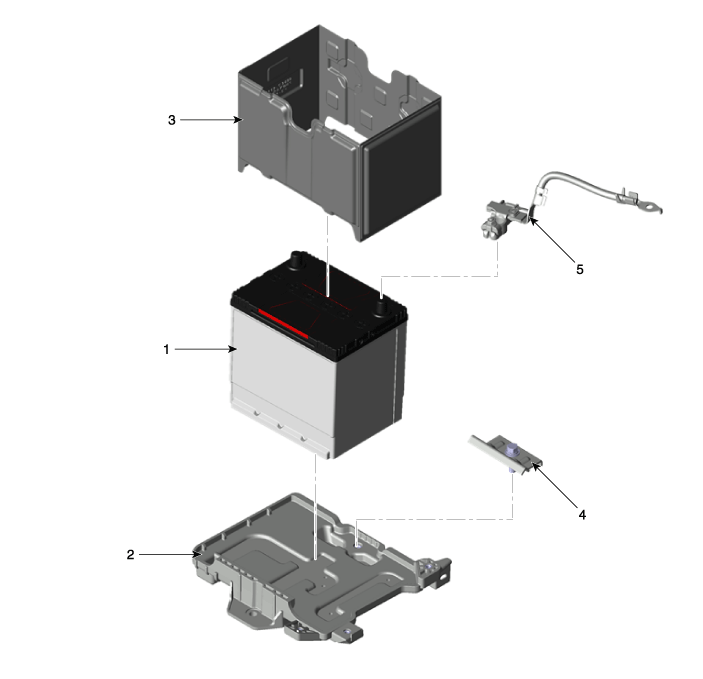
1. Battery
2. Battery tray
3. Battery insulation pad
|
4. Battery mounting bracket
5. Battery sensor
|
Repair procedures
Battery
| 1. |
Turn the ignition switch OFF and disconnect the battery negative (-)
cable (A).
|
| 2. |
Disconnect the positive (+) terminals (B) from the battery.
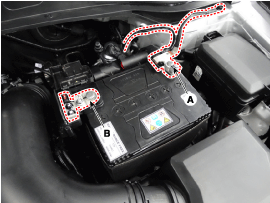
|
| 3. |
Remove the battery insulation pad.
|
| 4. |
Remove the battery mounting bracket (B) after loosening the bolt (A).
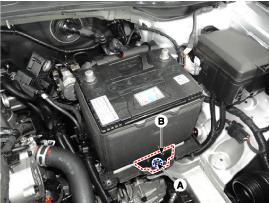
|
Battery tray
| 1. |
Remove the battery.
(Refer to "Removal")
|
| 2. |
Remove the air cleaner assembly.
(Refer to Engine Mechanical System - "Air Cleaner")
|
| 3. |
Remove the ECM.
(Refer to Engine Control System - "ECM")
|
| 4. |
Remove the battery (A) after loosening the bolts.
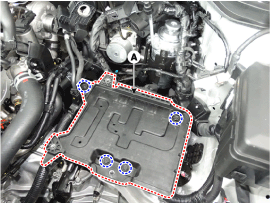
|
| 1. |
Install in the reverse order of removal.
|
Battery (-)terminal installation :
4.0 ~ 6.0 N.m (0.4 ~ 0.6 kgf.m, 3.0 ~ 4.4 lb-ft)
Battery (+)terminal installation :
7.8 ~ 9.8 N.m (0.8 ~ 1.0 kgf.m, 5.8 ~ 7.2 lb-ft)
Battery mounting bracket and the insulation pad installation
:
9.8 ~ 14.7 N.m (1.0 ~ 1.5 kgf.m, 7.2 ~ 10.9 Ib-ft)
Battery tray installation bolts :
8.8 ~ 13.7 N.m (0.9 ~ 1.4 kgf.m, 6.5 ~ 10.1 lb-ft)
|
| •
|
When installing the battery, fix the mounting bracket
on the tray correctly.
|
|
|
| Vehicle parasitic current
inspection |
| 1. |
Turn the all electric devices OFF, and then turn the ignition switch
OFF.
|
| 2. |
Close all doors except the engine hood, and then lock all doors.
| (1) |
Disconnect the hood switch connector.
|
| (3) |
Close the doors or remove the door switches.
|
|
| 3. |
Wait a few minutes until the vehicle’s electrical systems go to sleep
mode.
| •
|
For an accurate measurement of a vehicle parasitic current,
all electriacl systems should go to sleep mode. (It
takes at least one hour or at most one day.) However,
an approximate vehicle parasitic current can be measured
after 10~20 minutes.
|
|
|
| 4. |
Connect an ammeter in series between the battery (-) terminal and the
ground cable, and then disconnect the clamp from the battery (-) terminal
slowly.
| •
|
Be careful that the lead wires of an ammeter do not
come off from the battery (-) terminal and the ground
cable to prevent the battery from being reset. In case
the battery is reset, connect the battery cable again,
and then start the engine or turn the ignition switch
ON for more than 10 sec. Repeat the procedure from No.
1.
To prevent the battery from being reset during the inspection,
|
| a. |
Connect a jump cable between the battery (-) terminal
and the ground cable.
|
| b. |
Disconnect the ground cable from the battery (-) terminal.
|
| c. |
Connect an ammeter between the battery (-) terminal
and the ground cable.
|
| d. |
After disconnecting the jump cable, read the current
value of the ammeter.
|
|
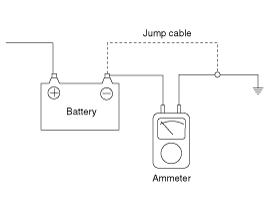
|
| 5. |
Read the current value of the ammeter.
| • |
If the parasitic current is over the limit value, search for
abnormal circuit by removing a fuse one by one and checking
the parasitic current.
|
| • |
Reconnect the suspected parasitic current draw circuit fuse
only and search for suspected unit by removing a compoconnected
with the circuit one by one until the parasitic draw drops below
limit value.
|
|
Limit value (after 10~20 min.) : Below 50mA
|
|
| 1. |
Make sure the ignition switch and all accessories are in the OFF position.
|
| 2. |
Disconnect the battery cables (negative first).
|
| 3. |
Remove the battery from the vehicle.
| •
|
Care should be taken in the event the battery case is
cracked or leaking, to protect your skin from the electrolyte.
Heavy rubber gloves (not the household type) should
be wore when removing the battery.
|
|
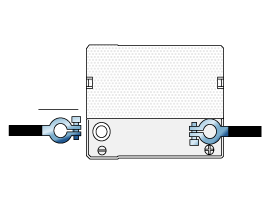
|
| 4. |
Inspect the battery tray for damage caused by the loss of electrolyte.
If acid damage is present, it will be necessary to clean the area with
a solution of clean warm water and baking soda. Scrub the area with
a stiff brush and wipe off with a cloth moistened with baking soda and
water.
|
| 5. |
Clean the top of the battery with the same solution as described above.
|
| 6. |
Inspect the battery case and cover for cracks. If cracks are present,
the battery must be replaced.
|
| 7. |
Clean the battery posts with a suitable battery post tool.
|
| 8. |
Clean the inside surface of the terminal clamps with a suitable battery
cleaning tool. Replace damaged or frayed cables and broken terminal
clamps.
|
| 9. |
Install the battery in the vehicle.
|
| 10. |
Connect the cable terminals to the battery post, making sure tops of
the terminals are flush with the tops of the posts .
|
| 11. |
Tighten the terminal nuts securely.
|
| 12. |
Coat all connections with light mineral grease after tightening.
| •
|
When batteries are being charged, an explosive gas forms
beneath the cover of each cell. Do not smoke near batteries
being charged or which have recently been charged. Do
not break live circuit at the terminals of batteries
being charged.
A spark will occur when the circuit is broken. Keep
open flames away from battery.
|
|
|
Troubleshooting
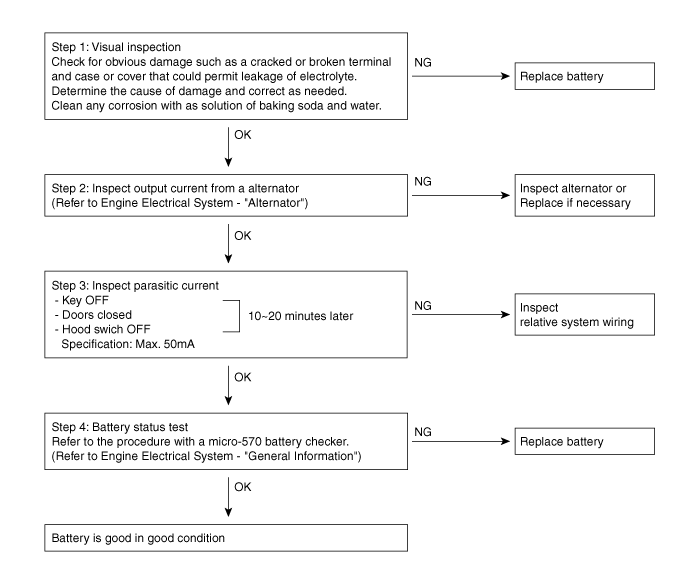
Description and operation
Description
The Alternator has eight built-in diodes, each rectifying AC current to DC current.
Therefore, DC current appears at alternator "B" ...
Description and operation
Description
Vehicles have many control units that use more electricity. These units control
their own system based on information from diverse sensors. It ...
Other information:
Hyundai Creta GS 2014-2025 Service Manual: Troubleshooting
▶Fault Diagnosis
Features a fail-safe mechanism that provides "limp-home" 4th gear hold to enable
the vehicle to be driven to the owner's home or dealer shop.
•
F ...
Hyundai Creta GS 2014-2025 Owners Manual: Parking brake
Checking the parking brake
Check the stroke of the parking
brake by counting the number of
“clicks’’ heard while fully applying it
from the released position.
Also, the parking brake alone should
securely hold the vehicle on a fairly
steep grade. If the stroke is more or
less t ...


 Alternator
Alternator Battery Sensor
Battery Sensor








